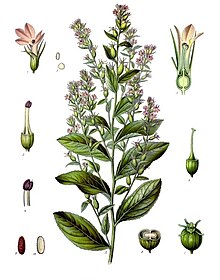|
Lobelia inflata
Lobelia inflata, also known as Indian tobacco or puke weed, is a species of Lobelia native to eastern North America, from southeastern Canada (Nova Scotia to southeast Ontario) south through the eastern United States to Alabama and west to Kansas.[3] Description Lobelia inflata is an annual or biennial herbaceous plant growing to 15–100 cm (5.9–39.4 in) tall, with stems covered in tiny hairs. Its leaves are usually about 8 cm (3.1 in) long, and are ovate and toothed. They are alternately arranged. It has violet colored flowers that are tinted yellow on the inside, and usually appear in mid-summer and continue to bloom into fall.[4] The seedcases are small, brown, dehiscent, and papery.[5] PropagationPropagation is usually accomplished by cuttings or seed. Seeds are sown in containers in mid spring or mid fall. The seeds take about 2 weeks to germinate. Traditional uses and adverse effectsLobelia inflata has a long use as a medicinal plant as an entheogenic, emetic, and skin or respiratory aid.[6][7] Native Americans used it for respiratory and muscle disorders, as a purgative, and as a ceremonial medicine.[6][7] The leaves were chewed and smoked.[8] The plant was used as a traditional medicinal plant by the Cherokee, Iroquois, Penobscot, and other indigenous peoples.[7] The foliage was burned by the Cherokee as a natural insecticide, to smoke out gnats.[7] Although it may be used medicinally,[9] consuming lobelia causes adverse effects, which may include sweating, nausea, vomiting, diarrhea, tremors, rapid heartbeat, mental confusion, convulsions, hypothermia, coma, or possibly death.[6][10] The root is toxic and can be fatal if eaten.[6][8] Chemical constituentsLobelia inflata contains multiple alkaloid compounds, including lobeline, norlobelanine, lobelanidine, and radicamine, among other compounds, such as flavonoids, terpenes, alkynes, and coumarins.[6][11][12] Lobeline concentration is highest in the seeds.[6] References
External links |
||||||||||||||||||||||||||||||||||

